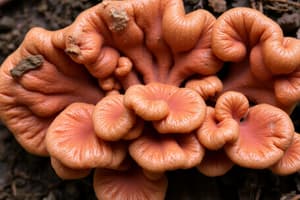Podcast
Questions and Answers
What distinguishes fungi from other groups of organisms?
What distinguishes fungi from other groups of organisms?
- They only reproduce asexually.
- They are exclusively parasites.
- They are unicellular and cannot form multicellular structures.
- They possess distinct morphological, biological, and molecular features. (correct)
What is a key function of adhesion factors in fungal pathogenicity?
What is a key function of adhesion factors in fungal pathogenicity?
- Regulating temperature tolerance
- Killing host immune cells
- Producing toxins
- Facilitating colonization on host tissues (correct)
Which type of fungi is primarily responsible for causing oral thrush?
Which type of fungi is primarily responsible for causing oral thrush?
- Aspergillus species
- Rhizopus species
- Candida species (correct)
- Penicillium species
Which of the following is NOT an example of an immune evasion strategy used by fungi?
Which of the following is NOT an example of an immune evasion strategy used by fungi?
What is the primary mode of reproduction for yeasts?
What is the primary mode of reproduction for yeasts?
What forms can dimorphic fungi take at different temperatures?
What forms can dimorphic fungi take at different temperatures?
What role do siderophores play in fungal pathogenicity?
What role do siderophores play in fungal pathogenicity?
What characteristic describes thermal dimorphism in fungi?
What characteristic describes thermal dimorphism in fungi?
Which of the following correctly categorizes fungi based on their medical importance?
Which of the following correctly categorizes fungi based on their medical importance?
Which of the following mechanisms contributes to antifungal drug resistance in fungi?
Which of the following mechanisms contributes to antifungal drug resistance in fungi?
Flashcards are hidden until you start studying
Study Notes
Fungi as Infectious Agents
- Fungi are unicellular and multicellular eukaryotes, classified in their own kingdom.
- They can be saprobes, symbionts, or parasites, playing diverse ecological roles.
Classification of Fungi
- Fungi are traditionally divided into yeasts and filamentous fungi based on observable traits.
- Fungal diseases in humans, known as mycoses, primarily result from yeasts and molds.
- Fungi are categorized by virulence and invasion levels: systemic, subcutaneous, cutaneous, or superficial infections.
- Key divisions include true pathogens that cause disease in healthy individuals and opportunistic pathogens that primarily affect immunocompromised hosts.
Molds
- Molds are multicellular fungi characterized by filamentous structures called hyphae, forming a mycelium.
- They reproduce through spores (sexual or asexual) leading to fuzzy or powdery colonies.
Yeasts
- Yeasts are unicellular fungi, reproducing asexually by budding or binary fission.
- They appear as smooth, creamy colonies in culture and include significant species like Candida and Cryptococcus neoformans.
- Candida can cause oral thrush and vaginal yeast infections, while Cryptococcus neoformans leads to cryptococcosis, impacting the lungs and central nervous system.
Dimorphic Fungi
- Dimorphic fungi can exist in two forms: yeast at body temperature (35-37°C) and mold at lower temperatures.
Factors Contributing to Fungal Pathogenicity
- Fungi can enter the body via respiratory or cutaneous routes.
- Pathogenic fungi exhibit thermal dimorphism and adapt to low oxygen levels.
- Virulence factors include:
- Adhesion Factors: e.g., mannoproteins, biofilm formation
- Enzymatic Factors: e.g., proteases and lipases
- Morphological Factors: ability to switch forms and hyphal growth
- Immune Evasion: capsule formation, antioxidant production, immune modulation
- Toxin Production: Mycotoxins (e.g., aflatoxins)
- Resistance Mechanisms: antifungal drug resistance and biofilm associations
Host Defense Mechanisms Against Fungi
- Defense includes anatomical barriers (skin, mucosal surfaces) and immune responses (innate and adaptive).
- Nutritional immunity involves sequestering iron from fungi using proteins like transferrin and lactoferrin.
Organization of Fungal Infections
- Fungal infections are categorized based on the pathogenicity of fungi:
- Coccidioides immitis spores lead to coccidioidomycosis, with around 100,000 cases/year.
- Inhaled spores may result in cold-like symptoms or be asymptomatic, particularly in people with AIDS.
Diagnosis and Control of Coccidioidomycosis
- Diagnosis relies on observing distinct spherules in tissue samples and antigen tests.
- Disseminated infections require treatment with amphotericin B.
Blastomyces dermatitidis
- Causes blastomycosis, with symptoms like cough, chest pain, and possible chronic systemic effects impacting various organs.
Cutaneous Mycoses
- Dermatophytoses affect non-living epidermal tissues, causing conditions like tinea (ringworm).
- Caused by genera like Trichophyton, Microsporum, and Epidermophyton primarily affecting skin, hair, and nails.
- Treatment often involves topical antifungal agents; recurrent vulvovaginitis is treated with over-the-counter ointments.
Cryptococcus neoformans
- Causes cryptococcosis primarily in immunocompromised individuals, presenting with respiratory symptoms that can lead to severe CNS infections.
- Essential treatment for systemic infections includes amphotericin B and fluconazole.
Diagnosis of Fungal Infections
- Diagnosis involves patient history, clinical presentation, and various laboratory methods including:
- Microscopy: using techniques such as KOH preparation and Calcofluor White staining.
- Culture methods: using specific agar types like SDA and BHI for growing fungi under various temperature conditions.
- Serological Tests: detecting antibodies or antigens using ELISA or Cryptococcal Antigen tests.
- Molecular Methods: PCR and DNA sequencing for identification.
- Imaging Techniques: X-rays or CT scans to assess deep infections.
Studying That Suits You
Use AI to generate personalized quizzes and flashcards to suit your learning preferences.




